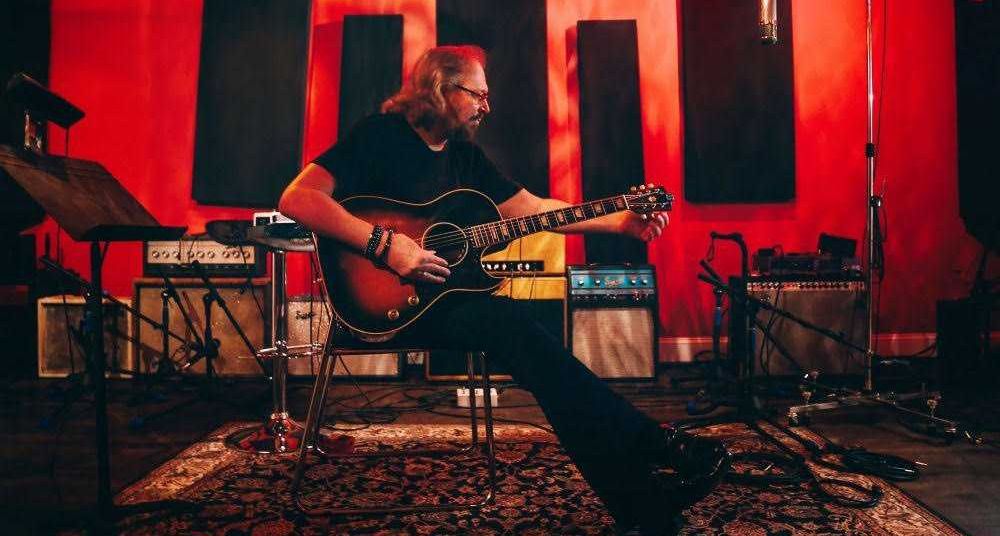Barry Gibb recalls brave Bee Gees TV performance of Bob Dylan song to protest the Vietnam War
In an Upworthy exclusive, Gibb shares how Dylan inspired his music and gave his generation a voice for peace.
The Bee Gees in 1963 and Barry Gibb in 2017.
In 1962, the Australian Army began its formal military commitment to the U.S war in Vietnam. Two years later, young men were required to register for the National Service scheme and forced to fight in a bloody war that would enlist over 80,000 Australians. Over the next 11 years, 523 Australians died in battle and nearly 2400 were wounded before the country withdrew.
The fear of being sent to Vietnam to kill or be killed for the government struck fear into the hearts of many young Australians in 1963. That’s why three teenage boys, Barry (17), Robin (14), and Maurice (14) Gibb, The Bee Gees, took their big moment on Australian TV to speak truth to power by singing Bob Dylan's “Blowin’ in the Wind.” The Bee Gees were relative unknowns that night on Bandstand, but by the end of the decade, they would be among the biggest acts in the world.
The Bee Gees sang 'Blowin' in the Wind' on Australian TV in 1963
“Blowin’ in the Wind,” released earlier that year, asks fundamental questions about war, racial justice, and whether humanity will ever live in peace and equality. The song would become one of the most important anthems in the Civil Rights and peace movements of the ‘60s and beyond.
- YouTube www.youtube.com
Barry Gibb, now 79, says that even as a teenager, he completely understood why Dylan’s song needed to be heard. “I was rapidly approaching the time when I would have to register for the draft,” he told Upworthy in an exclusive interview. “It's hard to explain that period, except that everyone was very worried, very worried, and Bob Dylan was our hero.”
“The Vietnam War was such chaos to the Australian people that it shadowed everything. I wrote a song called ‘And the Children Laughing’ because of what Bob Dylan had written. It's about life and dying, and the idea that you would die for your country or go and kill people you don't know. And I don't want to go kill people. It was not on the table for me. So everything he wrote touched me deeply,” Gibb continued.
Why don't you get on your feet
It's about time you got to think
Whatever happened to peace?
Well, open your eyes and you'll see children laughing
Voices singin', hearts a-beatin' ah…
- YouTube www.youtube.com
Barry Gibb has always believed in peace
“Blowin’ in the Wind” questions whether we can ever escape the never-ending cycles of generational violence and injustice. Gibb believed that through protest, it could be ended once and for all. “We go from one war to another as if the last one didn't happen at all. So I think there's that weariness. I'm against violence of any form, whether it's war, whether it's a fight in the street. I've broken up a few fights in the street, but I'm never involved in the idea of enjoying fights or enjoying killing somebody, because my government has told me to,” Gibb told Upworthy. “You know, you weren't allowed to vote at the age of 18, but you could go to Vietnam. So we had a big issue over there.”

Beyond Dylan’s activism, Gibb found inspiration in his controversial musical experimentation, whether it was shocking the folk scene by going electric in 1965 or his long history of rearranging his songs, sometimes at the last minute, so they hardly resemble their original forms. “He was just experimenting all the time. And 'My Back Pages,' the fact that he would change the entire arrangement, still have the same words. I thought that was just fine,” Gibb said. “He's playing it all in different ways. But as you know, we've just got to sit with the fact that it's a genius. And nothing could stop that, not then, not now."
”Bob Dylan, George Harrison, Tom Petty, Neil Young, Eric Clapton, and Roger McGuinn playing "My Back Pages" at the Bob Dylan 30th Anniversary Celebration in 1992.
- YouTube youtu.be
Ultimately, Gibb calls Dylan the “reason” he “picked up a guitar” and the catalyst for everything he and his brothers accomplished. “We lived through all of it right up through [Saturday Night] Fever, right up to now, we just lived through every second of it and had a ball. But, I have to say, it's because of someone like Bob Dylan. He lit the fire underneath all of us.”
